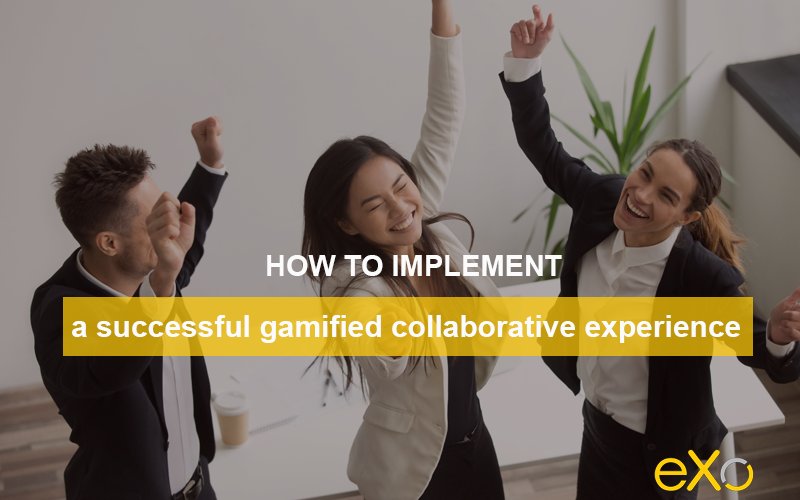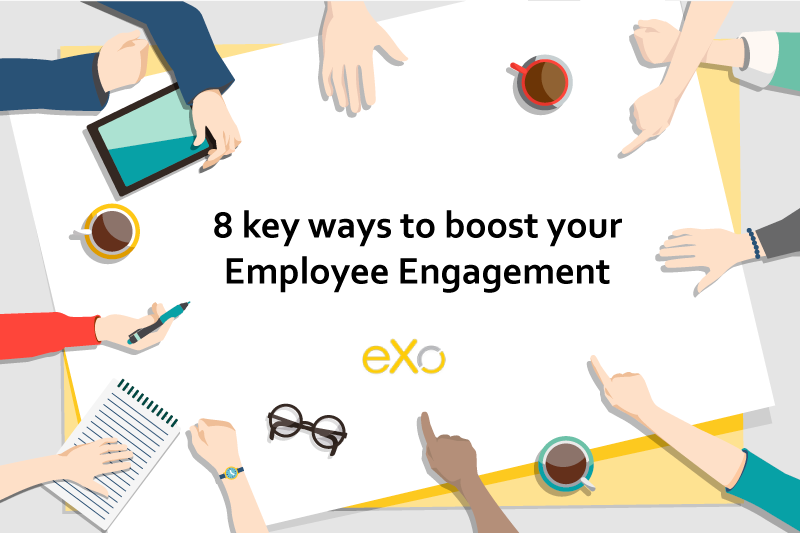- Patrice Lamarque
- July 24, 2018
The gamification of a digital workplace to support employee engagement (2/2)
This post is the second part of a two-part article about gamifying a digital workplace to generate employee engagement. Read the first part.
In the first part of this article, we have shown how a gamified digital workplace constitutes an enabling environment for employee engagement. Now let’s see how to implement a successful gamified collaborative experience.

Content
1. Gamification and motivation
Have you ever found yourself preferring to play one last level of Candy Crush when it’s really time to put on your running shoes for your weekly jog? This dilemma is due to the different natures of your motivations for these activities. What pushes you to run is the prospect of being able to finish that pint of caramel ice cream without remorse or fear for your waist size. Having fun aligning rows of candy on your smartphone, on the other hand, satisfies your intrinsic motivation.
A gamified environment uses the same motives as games: the desire to solve new problems, progress on a scale of levels, and receive frequent and direct feedback to move forward step by step. The “player” also has a certain autonomy to experiment. He has meaningful goals to achieve and social interactions to have.
Implementing a properly gamified work environment therefore requires recreating a certain number of these game mechanics that tap into intrinsic motivations.
The notion of motivation also applies to the rewards that can be earned in the “game.” At work, pay, bonuses, and benefits undoubtedly play a role in motivating people, but they are extrinsic motivators. It’s motivators of a different nature that really make people move. In Gamification by Design, Gabe Zichermann defined the SAPS model that categorizes the rewards that need to be defined in a gamified environment:
Status: a position in relation to others Access: access to information from people not everyone has access to Power: power over other people, objects, or information Stuff: things are not easily accessible to others
To sum up, by gamifying a work environment, we will ensure that the behaviors we want from employees are linked to their intrinsic motivations. There are a number of techniques and forms of rewards to be implemented.
2. Different profiles of players
A gamification expert, Professor Ian McCarthy, analyzed the principles of gamification. First of all, it appeals to our natural propensity to collect all sorts of things. We play for rewards that we collect: these can be points, medals, pictures, trophies, etc.
Obviously, we are not all sensitive to the same things. There are, in fact, several player profiles that we will also find in the workplace:
The “strivers” who play to surpass themselves. They want to set their own records for personal development. The “slayers” who play to beat others, stand out. The “scholars” who play to learn, who want to understand and master the rules of the game. The “socialites” who enjoy socializing and integrating. In the game, they collaborate and connect with others to get to know them better.
These different player profiles are not sensitive to the same game mechanics. For example, “strivers” and “slayers” will be interested in individual scores, rankings, and badges that reflect their achievements as well as increased difficulty as they progress through the game; otherwise, it will quickly seem boring. The “scholars” will look for new levels and advanced rules to go even deeper into the subtleties of the game. The “socialites,” for their part, will appreciate activities that can be carried out together.
It is interesting to note that playing as a team in a collaborative way and playing online at the same time in a virtual experience attracts all types of players. And these are two native characteristics in a collaborative work platform.
3. How to gamify the employee’s digital experience ?
We can see how all these mechanics can easily be transposed to a digital collaborative work environment. However, gamification should be seen as a positive way of leading employees toward virtuous behavior or behavior that brings value to the organization. In this area, each business pursues its own objectives and will therefore have to define appropriate rules of the game.
Let’s take some examples of classic problems that a digital workplace can solve through gamification:
- Employee onboarding. For new recruits, you could define a program allowing them to be trained in the company’s tools and immerse themselves in the corporate culture through successive missions consisting of reading tutorials or performing certain actions in applications (creating a task, posting a presentation message, etc.). They would earn badges and could view their progress.
- Streamline communication. Here is another recurring topic. In this case, you could award points to a person for each post they publish or even each post they relay. Or display a ranking of the people whose communications reach the largest number of distinct readers.
- Sharing knowledge. You could award badges to those who submit the most answers in the discussion forums dedicated to the themes that really matter to the company’s strategy. Or reward points to those who make the effort to write an article for your knowledge base or create links and tags that help structure the information.
- Teamwork. To encourage people work together more, you could award points to those who comment in your task management app. You could also reward those who are active in spaces identified as project spaces.
- Innovation. To foster innovation, you could gamify your idea box, with a mission granting a reward of 1,000 points to those whose ideas are officially selected to be implemented. Or you can display a ranking of those who share the best articles on selected themes.
The list is obviously not exhaustive. But as you can see, each issue can bring value and be promoted using various gamification elements. The possibilities are only limited by your imagination.
You will definitely need creativity because the game will have to evolve regularly. Indeed, all games cause a certain weariness after a while. This is the natural habituation phenomenon. As soon as players have reached the objectives (or stop progressing), they’re at risk of losing interest in the game if you do not update it. It will therefore be necessary to stimulate players by constantly proposing new missions. You will also need to adjust point allocation rules and add new rewards and levels. You will need to align all this with the objectives of your organization, as well as the actual progress of the players.
Finally, and this is certainly the most important part, you will need specific monitoring indicators for gamification to measure both the progress of players and the impact on the performance indicators of your digital workplace. For example, have your new rules on knowledge management really contributed to improving the quality of the knowledge base? Does it make it easier for employees to find information?
4. Players, users or employees?
With gamification, the employees you want to engage become users as soon as they start adopting the digital workplace. They then become engaged players as soon as the gamified experience motivates them.
These are interesting perspectives on the employee experience, but there is one point to remain vigilant about. While the adoption of tools can create the illusion of user engagement, what really matters is employee engagement in their daily work. And this engagement requires that good practices be firmly anchored in the company’s culture so that both the organization and its employees can benefit from them.
Do you think gamification of your digital workplace can change the game? The game is open– tell us what you think in the comments!
5/5 - (1 vote)
I am the product officer at eXo. I oversee product management and product marketing. My teams design, create and promote the features of and improvements to eXo Platform. As a former enterprise software developer turned product manager, I have a passion for how IT can improve people’s lives.
In this blog, I write about some of my personal interests, such as productivity, alternative forms of management and corporate organisations, collaboration, open-source and emerging technologies.
Related posts
- All
- eXo
- Digital workplace
- Open source
- Internal communication
- Collaboration
- News
- intranet
- Future of work
- workplace
- Knowledge management
- Employee engagement
- Employee experience
- Employee productivity
- onboarding
- Employee recognition
- Change management
- Cartoon
- Digital transformation
- Infographic
- Remote work
- Sneak Peek
- Solutions
- Thought leadership
- Tips & Tricks
- Tutorial
- Uncategorized
Leave a Reply
( Your e-mail address will not be published)
Connexion
0 Comments
Commentaires en ligne
Afficher tous les commentaires


